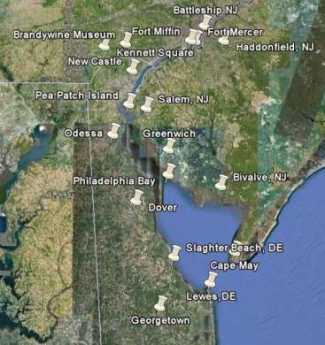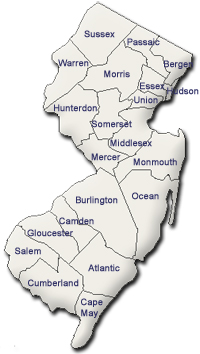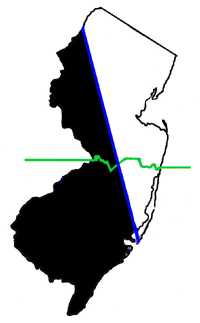Related Topics
Land Tour Around Delaware Bay
 Start in Philadelphia, take two days to tour around Delaware Bay. Down the New Jersey side to Cape May, ferry over to Lewes, tour up to Dover and New Castle, visit Winterthur, Longwood Gardens, Brandywine Battlefield and art museum, then back to Philadelphia. Try it!
Start in Philadelphia, take two days to tour around Delaware Bay. Down the New Jersey side to Cape May, ferry over to Lewes, tour up to Dover and New Castle, visit Winterthur, Longwood Gardens, Brandywine Battlefield and art museum, then back to Philadelphia. Try it!
New Jersey (State of)
 The Garden State really has two different states of mind. The motto is Liberty and Prosperity.
The Garden State really has two different states of mind. The motto is Liberty and Prosperity.
Revolution in New Jersey
Early, brief but significant.
Day One: Camden to Cape May
 Settlements for three centuries have clustered along both sides of the Delaware Bay, like beads on two parallel strings. 
|
| Dr. Fisher |
The Capital of southern New Jersey alternated between Salem and Burlington, and the King's Highway ran between them atop a clay ridge all of fifty feet above sea level. Colonial villages are strung along Kings Highway about ten miles apart, just like villages in the Midwest and for the same reason. That's about the distance a farmer's wagon could travel to market and return in one day. Travel by boat modified that somewhat. One unexpected feature: the marl clay ridge was eventually found to contain the first known dinosaur bones, still proudly on display at the Academy of Natural Sciences. We'll defer until Day Two describing the interesting origins of the coastal route on the Delaware side of the bay below the big river bend at Salem. In New Jersey the counterpart is the Del-Sea Drive, now rapidly fragmenting in response to school crossings and traffic. Although almost everything of interest is along these three roads, for this tour we propose taking President Eisenhower's interstate highway system, with side-trips as needed.
The retreating British Army ferried out of Philadelphia in 1778, went from Camden to Haddonfield and turned north on King's Highway. For this tour, we turn south from Haddonfield, pausing for a glance back at Camden. Poor Camden scarcely exists anymore, but the battleship New Jersey is parked there, the waterfront view is awesome, and Walt Whitman's home is open to tourists. Once the home of shipbuilding, Campbell's Soup, RCA/Victor, and the terminus of railroads at the ferries to Philadelphia, the town was first threatened by isolation by the Pennsylvania Railroad going down the other side of the river in 1839, but ultimately made economically redundant by the construction of the Ben Franklin Bridge in 1926. An interesting sociological study called Camden After the Fall relates how one futile effort after another to restore Camden after 1950 led only to riots and chaos; it's difficult to suggest anything which has not already been tried and abandoned. The present unstated but relentless approach is to tear the obsolete buildings down as they deteriorate, leaving vacant land which will eventually coalesce and become attractive to developers. Toll houses could be found along the turnpike to Haddonfield until 1960, but the automobile made Camden obsolete. What's left begins with the suburbs five miles away.

|
| New Jersey Line |
Haddonfield was a plain little Quaker town with undiscovered dinosaurs buried underneath it until the Revolution when the fugitive New Jersey legislature met in the Indian King Tavern and created the State of New Jersey. Because the Pennsylvania/New Jersey fortifications of the Delaware River at Fort Mifflin/Red Bank blocked the British fleet, Hessians were sent to attack New Jersey's Fort Mercer from the rear, staying overnight in Haddonfield. One young Quaker, a famous runner, ran ten miles to alert the defenders of Fort Mercer, who then defeated the Hessian attackers the next day by pretending not to notice the Hessians until they suddenly turned around and ambushed them. Later on, after the British occupied Philadelphia, General "Mad Anthony" Wayne rounded up cattle in Salem County and drove them to Trenton, then over to Valley Forge to relieve Washington's starving troops. The British responded to this with a famous massacre in Salem County by cavalry under Col. John Simcoe. So off we go to National Park, originally called Red Bank because of the reddish color of the clay riverbank at that point on the river, to see Fort Mercer. From here we travel to Salem, seeing its sadly dilapidated Colonial buildings, and the oak tree which was already famous among the Indians for its huge size in 1683. Along King's Highway, we pass through Mickleton, Mullica Hill, and Woodstown, three cute little Quaker villages waiting to be overwhelmed as suburbs.
From here we go to Greenwich, named for Connecticut settlers, where Paul Revere stirred up a tea-burning party in sympathy with the Boston event, on his way to promote even greater agitation in Philadelphia. Greenwich is sometimes referred to as a second Williamsburg, but what's here is original, not reconstructed. In passing, this tour takes us past Hancock's Bridge where Simcoe massacred those farmers who sold cattle to Anthony Wayne. That's biased local history speaking; in fact, Tory-Rebel reprisals were very bitter on both sides. Until ten years ago, this blood-stained site stood alone in the lonely moors, but unfortunately, it's pretty much built up and harder to find in the new suburbs than it was in the reeds.
From Greenwich we go on to Cape May, with a brief detour to Bivalve. The point about this stop is the perfectly gigantic pile of oyster shells left over from the days as a center of oyster harvesting. Notice the roads; they're paved with oyster shells. Oysters eat algae, sewage fertilizes algae. Overfishing the oysters caused rotting algae and bacterial overgrowth in the river. The result was depletion of the dissolved oxygen, dead areas for fish, murky water instead of a clear stream. It's an opportunity for oyster farming, but the vast piles of shells at Bivalve are a warning of how far we have to go before we restore the river.
Cape May was the first Atlantic Ocean beach resort, reached from Philadelphia and Tidewater Virginia by boat long before roads were usable. We are told Cape May was originally a separate barrier island, joined to the rest of South Jersey only later. It was once a whaling port, and the Quakers of the region were more related to Nantucket than to Philadelphia. Whale-watching is popular here, but dolphin sightings are more reliably frequent. As you would expect, this cute little place has many fine restaurants and hotels. The hotels are so authentic that strangers share common bathrooms the way they always used to do, so bed and breakfast places can be preferable for snootier tourists. Those whose great-grandparents once stayed in places like the Chalfonte, however, find it important to rough it in traditional summer places. The ocean currents "tumble" the small stones in the beach so beach-walkers can amuse themselves looking for "Cape May Diamonds". Unfortunately, even the locals often have never heard of them, so you are probably on your own. From here, we take the forty-minute ferry ride to Lewes, Delaware.
Cape Henlopen, on the Delaware side of the entrance to the bay, is south but appreciably to the east of Cape May. That means that a line directly west from Cape May points well inside the mouth of the bay, to Slaughter Beach, or Mispillion Point on the Delaware side. The ocean salt water turns to fresh river water at about this level, making for remarkably good fishing at certain times of the year. Furthermore, horseshoe crabs come ashore here on both sides of the bay to lay eggs. Birds who took off from South America months earlier swoop out of the skies to eat the crab eggs on the appointed day. Hawks pause in the woods to fly together in flocks over the bay, based on their own signals. Mispillion Lighthouse is the greatest place on the Atlantic flyway for bird-watching, crab-watching, fishing and nature loving. But you have to know when to go there and remember the best local hotels do get filled up at those times.
REFERENCES
| Paul Revere & The World He Lived In | Amazon |
| Camden After the Fall: Decline and Renewal in a Post-Industrial City: Howard Gillette Jr.: ISBN-13: 978-0812219685 | Amazon |
Originally published: Wednesday, April 04, 2007; most-recently modified: Thursday, May 16, 2019